August 16, 2013
Air Date: August 16, 2013
FULL SHOW
SEGMENTS

Pollutants Implicated in ADHD
View the page for this story
About one in every ten children in the United States has been diagnosed with ADHD. Now scientists at Laval University in Quebec say some environmental pollutants increase the incidence of attention problems. Dr. Gina Muckle tells host Steve Curwood about her study demonstrating an association between ADHD in children and exposure to lead and mercury. (06:40)
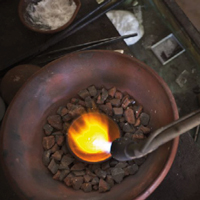
Mercury Hot Spots Around the World
View the page for this story
A new report finds hotspots of unsafe mercury levels world wide. David Evers, chief scientist at the Biodiversity Research Center tells host Steve Curwood that millions of people rely on fish with unsafe mercury levels as their principle source of protein. (06:20)
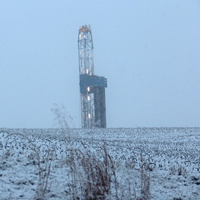
Fracking on Amish Lands
/ Reid FrazierView the page for this story
Amish communities live a simple life, and mostly shun modern technology. But in Carroll County, Ohio, many Amish farms sit on top of rich gas shale beds, and most Amish there welcome fracking, and its rewards. Reid Frazier reports. (08:00)

Science Note: A Plant With Oily Leaves
/ Naomi ArenbergView the page for this story
In a bid to increase biofuel extraction from plants, researchers at Michigan State University engineered a plant with high levels of oil in its leaves. Naomi Arenberg reports. (01:55)

The World's Largest Known Organism In Trouble
View the page for this story
The world’s largest and possibly oldest living organism is Pando, a Quaking Aspen clone in Utah. Karen Mock, Professor of Molecular Ecology at Utah State University tells host Steve Curwood that estimates reckon Pando is 80,000 years old. But according to Paul Rogers of the Western Aspen Alliance, over grazing from deer and elk are now threatening the massive tree's existence. (09:35)
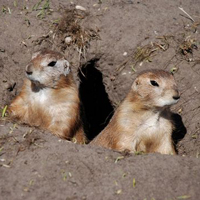
Can Prairie Dogs Save Mexico's Prairie From the Desert?
/ Ari Daniel ShapiroView the page for this story
There were once billions of black-tailed prairie dogs across the prairies of the West and Mexico. Today there is only a fraction of the original population left but activists in Mexico are working to bring back the prairie dogs and help restore the prairie along with them. (05:40)

Conservation Canine
View the page for this story
Scientists at the University of Washington are using rambunctious rescue dogs to track down endangered species in their natural habitat. The Conservation Canines work all over the world — tracking elephants in Africa and Orcas in the Pacific. Professor Samuel Wasser tells host Steve Curwood about their work chasing salamanders and in the controversial tar-sands area of Alberta. (09:25)
Show Credits and Funders
Show Transcript
Host: Steve Curwood
Guests: Gina Muckle, David Evers, Karen Mock, Paul Rogers, Samuel Wasser
Reporters: Reid Frazier, Naomi Arenberg, Ari Daniel Shapiro
[THEME]
CURWOOD: From Public Radio International, this is Living on Earth.
[THEME]
CURWOOD: I'm Steve Curwood. Mercury is toxic if you ingest it - and it can affect brain development in children -- and scientists are finding it almost everywhere they look --
EVERS: We found mercury to be very ubiquitous in the environment. We found it in the marine ecosystems, in freshwater ecosystems, we found elevated levels in the northern hemisphere, as well as the southern hemisphere.
CURWOOD: Mercury hotspots around the globe. Also a Mexican scientist unravels the mystery of why some prairies turned to desert: what was missing, and what happened when the prairie came back.
CEBALLOS: It was mind-blowing because all the way to the horizon – there were prairie dogs and prairie dogs and prairie dogs. And then the next day we saw badgers. Badgers are very rare in Mexico. Golden eagles are also very rare in Mexico, and we saw more than 20 there in one single day.
CURWOOD: That and more this week, on Living on Earth. Stick Around!
[NEWSBREAK MUSIC: Boards Of Canada “Zoetrope” from “In A Beautiful Place Out In The Country” (Warp Records 2000)]
ANNOUNCER: Funding for Living on Earth comes from Stonyfield Farm, makers of organic smoothies, yogurt and more.
Pollutants Implicated in ADHD

Dr. Gina Muckle
CURWOOD: From the Jennifer and Ted Stanley Studios in Boston, this is an encore edition of living on Earth. I'm Steve Curwood. At least one in every ten school-aged children in the United States has been diagnosed with ADHD, and over the last decade, prescriptions for attention deficit medications are up nearly 50%. There are many theories about the cause of the increase in ADHD, but scientists from Laval University in Quebec have new evidence implicating two notorious toxins. In a study in Environmental Health Perspectives the researchers found an association between ADHD in children and exposure to mercury and lead. Joining me from Quebec City is one of the study's authors, Dr Gina Muckle, who's a professor of psychology at Laval University - welcome to Living on Earth!
MUCKLE: Thank you!
CURWOOD: So, you conducted this study up in the Canadian Arctic. Tell us a little bit about that region and why you chose to do your research there…
MUCKLE: In the northern part of the province of Quebec, there’s about 11,000 Inuit living in the north. And, we’ve discovered in the beginning of the 80s that this population was the most highly exposed population in the world with regards to PCBs and mercury. So, we decided that time that we would follow a cohort of babies by picking core blood samples at their birth and follow them up to school age.
CURWOOD: Could you please explain the specifics of your study to me?
MUCKLE: Yes. About 300 newborns were born between 1993 and 1996, provided core blood samples to us so that we could assess their neonatal exposure to environmental contaminants such as mercury, lead, and PCBs. While they were at school-age - which is about 11 years - we saw this group of children again and we did an interview with their mother to document different cognitive growth and behavioral effects that we could see in association with their prenatal exposure.
At that age, we asked their schoolteacher to fill in forms to document ADHD behavior.
CURWOOD: Now, how exactly did you measure attention deficit disorder?
MUCKLE: Well, there are questionnaires that we can use that are well used all around the world aimed to assess the manifestations of ADHD which are inattention difficulties in school, aggressive behaviors, non-respect of rules and hyperactivity symptoms. So the teachers were asked to assess those behaviors for all of the children.
CURWOOD: And what were your findings?
MUCKLE: The first and most important result was that prenatal mercury exposure was associated with greater attention problems, and, with an increased risk of teacher-reported symptoms consistent with ADHD. To be more specific, what we observed is that children with higher core mercury concentrations at birth, were about 3 times more likely to be identified by their teacher in the classroom as exhibiting behaviors characteristic of the inattentive type of ADHD.
CURWOOD: And what did you find for lead?
MUCKLE: This exposure was related to greater aggressive and mood-breaking behaviors, and with behaviors consistent with ADHD. Actually, Inuit 11 year-old children who were exposed to lead were about four to five times more likely to be classified with hyperactive impulsive ADHD by their teacher.
CURWOOD: Now, how is it that mercury and lead get into these Inuit children?
MUCKLE: Well, the main exposure source of mercury of the Inuit population is through consumption of beluga meat. And the main source of exposure of lead is through the use of lead containing ammunition for hunting.
CURWOOD: How relevant are these results for non-Inuit children? Those, say, living in the United States, or elsewhere in Canada?
MUCKLE: For lead, the effects that we are reporting are seen at very low levels of exposure. We can estimate from the Canadian Health survey in Canada that there’s about 10 percent of Canadian children between six to 11 years who might be exposed to levels greater than the ones where we saw negative effects.
According to the CDC in the US, there’s about half a million of US children aged between one and five with blood lead levels above five micrograms per deciliter, which corresponds to about 2.5 percent of the US population. And the effects that we are reporting are below this five micrograms per deciliter. So there’s certainly, at least in the US, more than five percent of the population who are exposed to those levels.
CURWOOD: What are the primary sources of lead and mercury throughout North America?
MUCKLE: Mercury travels between countries through air currents - it’s reached the Arctic as well, and mercury emissions are the primary source of human exposure. Mercury emissions are primarily due to coal combustion for production of electricity, and in Canada, it’s probably about the same as it was in the United States – China was identified as the largest source of mercury deposition. They are responsible for about 45 percent of the entire mercury deposition in Canada.
CURWOOD: What do you hope will come out of your research?
MUCKLE: We do need to have much more information in what are the determinants of child behavior, especially ADHD. And so far the scientific research has been conducted to look at many different determinants of ADHD and I think we are just starting to look at the environment - the physical environment and the chemical environment - as a potential determinents of such kinds of difficulties in children. So what we hoped is to be able to contribute to the explanation of behavioral difficulties in children.
CURWOOD: Dr. Gina Muckle is Professor of psychology at Laval University in Quebec City. Thank you so much.
MUCKLE: Thank you very much… it was a pleasure!
Related link:
Read the Full Report
Mercury Hot Spots Around the World

Small-scale gold miners add mercury to fine particles of gold. The gold binds to the mercury and can then be easily sifted out. (Biodiversity Research Institute)
CURWOOD: Now, though mercury - or quicksilver - can be dangerous when ingested, it's also one of the strangest heavy metals. It's shiny and liquid at room temperature, and ancient alchemists were intrigued by its ability to dissolve other metals, including gold and silver - but not iron. But the ancients didn’t know how toxic mercury is, especially to the brain and kidneys, and even fairly recently it was widely used in medicine, for thermometers, dental fillings and vaccines. It's also abundant in coal, and coal-burning power plants, along with mercury-based gold mining, have created dangerous levels of mercury pollution worldwide. That's according to David Evers, executive director of the Biodiversity Research Institute, who spoke to us from Geneva. Mr. Evers and his colleagues tested mercury levels around the world to produce a report called “Global Mercury Hotspots."
EVERS: We found mercury to be very ubiquitous in the environment. We found it in the marine ecosystems, in freshwater ecosystems, we found elevated levels in the northern hemisphere, as well as the southern hemisphere. So that was the interesting finding from this, is that wherever we looked, we found mercury to be quite elevated. Some of the places that we found especially elevated are in eastern Asia, in India and China in particular, as well as Europe, in the Mediterranean Sea, and parts of South America.
CURWOOD: What’s the source of all this mercury in the environment worldwide?
EVERS: I think there’s two categories. Thirty-two percent of the emissions are from small-scale gold mining. So that’s the use of mercury to amalgamate with gold while you’re in the field, and to burn that mercury off so you have gold left in the bottom of your pan. That burning of that mercury and that release into the air by 20 or more million people is adding to the mercury emissions into the global pool. And the second piece is the coal-fired power plants. So the burning of coal...in some ways you’re burning in an instant potentially thousands of years of mercury deposited in that piece of coal by nature. So those are the two sources of mercury that are probably most problematic at a global level.
CURWOOD: In the US, of course, there are not a lot of people practicing small scale gold mining, so is it safe to say most of our exposure in the US, the mercury is coming from fish? And could you please then explain that mechanism of exposure?

Fish are the principle source of protein in many developing countries. Researchers worry that millions of people are consuming mercury at unsafe levels in the form of fish. (Biodiversity Research Institute)
EVERS: Sure. The exposure for an average person in the US is primarily through methylmercury in fish. It’s the larger organisms that live long that are on the top of that food web that are most problematic. And a lot of times, you’ll see in the newspaper or wherever and you’ll hear about tuna and swordfish, and it’s very true. Those are species that are long-lived and are on top of that food web, that carry enough methylmercury in their bodies that if we eat them regularly, then that can increase the mercury levels in our own bodies to troublesome levels.

Some tuna species are known to be exceptionally high in mercury and are not safe for consumption. (Biodiversity Research Institute)
CURWOOD: So if someone is concerned about fish that has mercury in it, what should one do? Is there a difference between wild-caught and farm-raised, or a difference between ocean and freshwater?
EVERS: First of all, fish is a very good resource for us to use, and we have to be smart about our choices and our picks. Generally, farm-raised fish are lower in mercury than wild fish, and some fish have higher mercury levels in their bodies, but they may have very good omega-3 fatty acid levels in their body. So sometimes there could be tradeoffs in choosing which fish you want. If you want to eat fish low in mercury, and high in omega-3, salmon and herring are very good for you.
CURWOOD: And what about freshwater versus the ocean?
EVERS: Both sort of ecosystems, marine and freshwater, have the ability to methylate mercury and get up into the food web where it can cause some harm to us. And if we look at species of fish that we commonly eat in the Great Lakes region, for example, such as pike, or walleye, or bass, those are fish species that can commonly get over one part per million, which is fairly high.
CURWOOD: You looked closely at 14 different countries for mercury exposure. What was the percentage of people that had concerning levels of mercury in their hair?
EVERS: In those 14 countries that we examined, we found that 84 percent of the mercury in fish were over our threshold level that we used, of .22 parts per million. That’s equivalent to one, six-ounce fish meal per month. And we also found, in the hair samples of people around the world in these 14 countries, that 82 percent of the hair samples exceed the EPA’s reference dose of one part per million.
CURWOOD: Now, last year, in 2012 that is, the US EPA promulgated the 'mercury in air toxic standards' which will remove 90 percent of mercury from coal-fired power plants in the US over the next couple of years, so we’re making good progress in this country, but China and India are pretty busy with coal-fired power plants. How freely does mercury travel around the world, and what kind of emissions of mercury are we headed for if these new power plants in Asia continue to grow?

After the mercury and gold are bound together miners burn them so the mercury vaporizes and all that remains is pure gold. The miner can inhale the vaporized mercury. (Biodiversity Research Institute)

Along with artisanal gold mining, coal fired power plants are one of the biggest sources of global mercury emissions. (Biodiversity Research Institute)
EVERS: The US has really pulled together, I think, a very good role that will be successful in removing 90 percent or more of mercury from emissions from coal-fired power plants, and I think that can be done quite quickly. Probably a bigger looming problem is the mercury that’s getting up into the upper atmosphere, into that global pool. And some of the key sources for that mercury in the global pool are China, India and coal-fired power plants. And so once that mercury is up into the global pool it does move over across the northern hemisphere, across North America, and it does deposit in North America. How much that will impact the US and Canada is still something that a lot of modelers are looking at. A lot of people are trying to better understand, but I’ll mention a study I had in the Great Lakes. We found that there was an uptick in the last decade of mercury in different species of fish, and birds, and other organisms. And so I think it is something we need to keep in our mind that even though we do clean up our backyard there is more work to be done.
CURWOOD: David Evers is the executive director of the Biodiversity Research Institute. Thanks so much for speaking to us from Geneva.
EVERS: You bet, Steve. Thanks for having us on the show. Thank you.
Related links:
- Report- Global Mercury Hotspots
- Biodiversity Research Institute
[MUSIC: Evers: Andrew Bird “Give It Away” from Break It Yourself (Mom & Pop Records 2012)]
CURWOOD: Just ahead – why some Amish farmers are embracing natural gas fracking - stay tuned to Living on Earth!
[CUTAWAY MUSIC: Davell Crawford: “The Cat” from The B-3 And Me (Bullseye Blues Records 1998)]
Fracking on Amish Lands
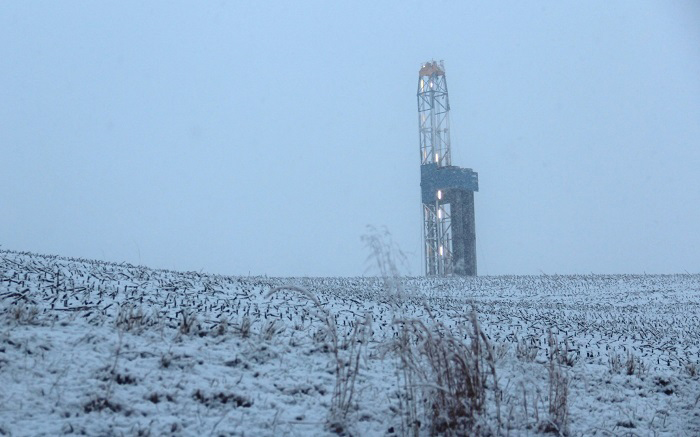
A gas rig in the winter. Carroll County, Ohio (photo: Reid Frazier)
CURWOOD: It’s Living on Earth, I'm Steve Curwood. Electricity, TV, the internet. The Amish generally live without these technologies, preserving a traditional way of life. But some Amish are saying yes to one very modern, very industrial technology: hydraulic fracturing or fracking for natural gas. In Ohio, some of the best pockets of oil and gas in the East run right under Amish country. The Allegheny Front’s Reid Frazier found the drilling is already changing the way some Amish there live.
FRAZIER: It’s an overcast day in Carroll County, Ohio, in the Southeast part of the state. An Amish farmer - dark wide brimmed hat, long beard, buttonless overcoat - is at work on his hillside farm. He mans the seat of what he calls his ‘hired hand’. It’s a skid steer loader, a kind of mini bulldozer he uses to haul huge piles of feed corn around his dairy farm.
[SOUND OF STEER LOADER]
FRAZIER: The Amish stay away from modern technology - but they do make some exceptions, and this diesel powered machine is one example. He was able to buy the machine with a new source of money - royalties. He leased his land for drilling a few years ago - he only got $15 an acre back then. But two years ago, Chesapeake Energy drilled a well on a neighbor’s farm. At around 7,000 feet down, the drill bit turned sideways, and went underneath his farm, following an oil and gas rich rock called the Utica shale. Soon after, he began receiving royalties - he won’t say how much.
The farmer, following the beliefs of most Amish, wouldn’t allow his voice or name to be used on the radio. But off tape, he said he saw no problem leasing his land for drilling. In his slight German accent, he says, The land was made for people to use.
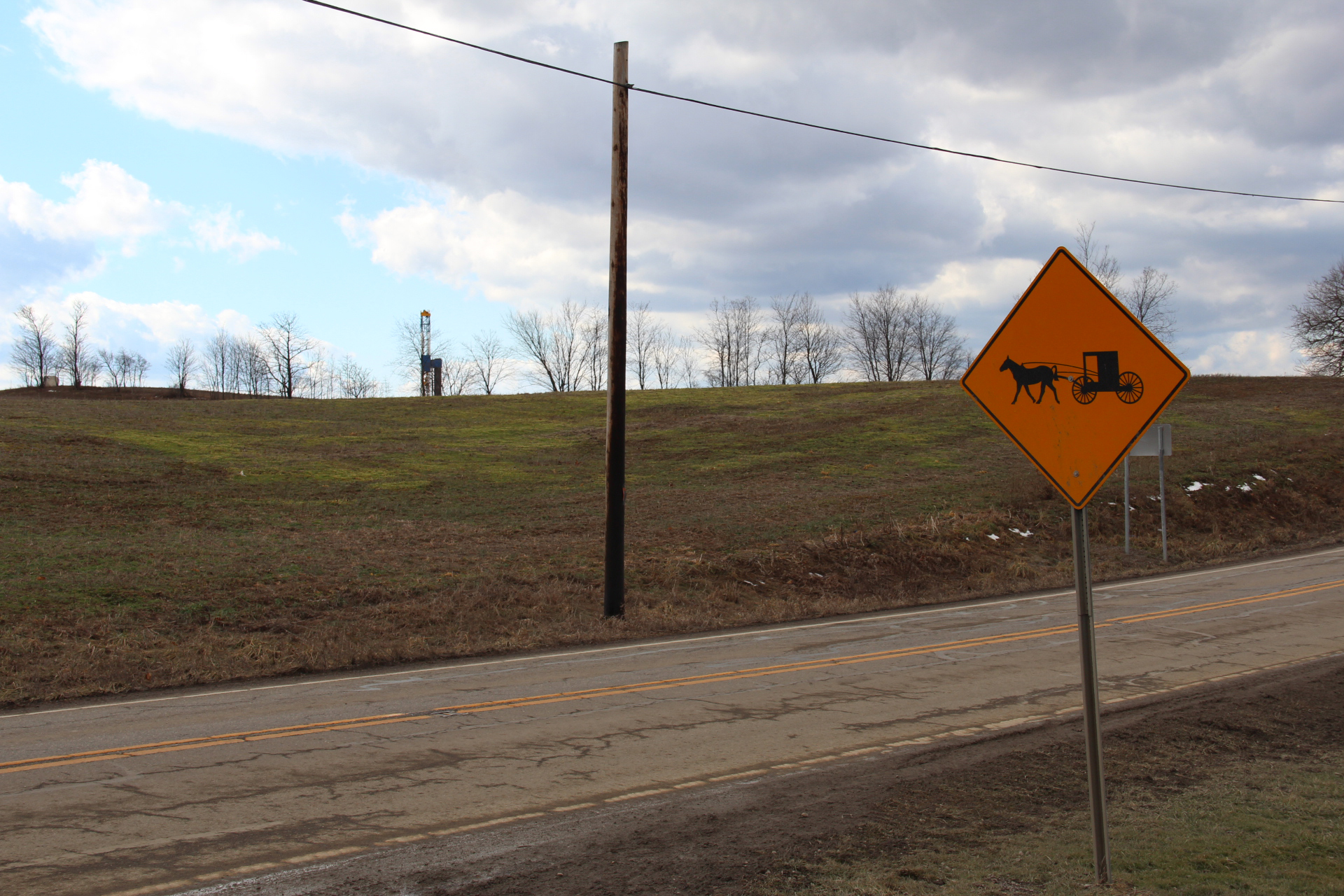
A Chesapeake drilling rig peaks over the horizon in Carroll County, Ohio (photo: Reid Frazier)
Many of his Amish neighbors feel the same way, and have leased their land for drilling. Rigs continue to migrate into this rural county - there are no four lane highways here, hardly any water and sewer services, and you can forget about most cell phone coverage. Drilling represents a whole new source of income for the Amish here, says Tom Wheaton. He’s a Carroll County commissioner.
WHEATON: I’d like to see how they’re going to handle it because it makes a major change for peoples’ lives.
FRAZIER: Case in point, one Amish dairy farmer. He’d been making $40,000 a year from farming.
WHEATON: And his first royalty check was for $80,000 -- one month.
FRAZIER: There is worry this kind of money could have a corrupting influence. As the Amish farmer with the new skid steerer says, The love of money is the root of all evil. And even if you didn’t want it, Ohio law makes it very hard to keep the industry from drilling under your land, if your neighbors want to drill on theirs. In those cases, the state can mandate your land be included in a drilling unit.
Because of this, and simple economics, drilling is here to stay in Carroll County. It’s got the most drilling permits of any county in Ohio. Everyday, it seems, more and more trucks hauling sand, water, and equipment crowd into the streets of the county seat, Carollton.
[CARS DRIVING ON DOWNTOWN STREETS]
It’s music to the ears of Amy Rutledge. She’s the director of the county’s Chamber of Commerce and visitors bureau. It’s been good for her, personally - she was working part time before the drilling started in 2011. Now she’s full time.
RUTLEDGE: You see hope in people’s eyes again, where it had gotten pretty depressed around here.
FRAZIER: Rutledge has seen the small Amish community grow since it started coming here in the 1980s. Many had come from Geauga County, east of Cleveland, which had experienced rapid growth in that decade.
RUTLEDGE: So they’re moving to areas that are not quite as built up.
FRAZIER: But in a twist of irony, these areas are now on top of some of the most lucrative rock formations in the East. One nearby well produced 30 million dollars in oil and gas. To capture this bounty, companies like Chesapeake use hydraulic fracturing, or fracking. This is a process in which millions of gallons of pressurized water, sand and chemicals are forced down a well to break up the fuel-rich rock.
This is a 24-7 industrial process in which thousands of trucks are needed to bring one well into production. It has been linked with groundwater contamination and methane migration in some states, though the industry says that if it’s done right, it’s safe. Fracking might seem at odds with Amish life. The Amish came to America beginning in the 18th century, and they abstain from some of the technologies that Americans take for granted. But don’t judge them by their horse and buggy, says David McConnell. He’s an anthropologist at Wooster College in Ohio who’s studied local Amish communities.
MCCONNELL: We tend to idealize the Amish and see them as all natural and organic.
FRAZIER: But that’s just not the case.
MCCONNELL: They are not Luddites, they are not stuck in the past with respect to technology use. The Amish believe that any decision about technology needs to be balanced with a discussion about the impacts of those technologies on community life.
FRAZIER: And sometimes that means embracing new technologies. That’s why some Amish choose to plant genetically modified crops, and use pesticides. Amish generally don’t feel a need to preserve the environment for the environment’s sake, either. McConnell says this can be traced to a basic tenet of Amish life - religion.
MCCONNELL: Most Amish would believe in a literal view of Genesis, they would believe that the earth was made by God and that humans have dominion over the earth.
FRAZIER: And that the earth is there for the benefit of humans, to use as they see fit. At the same time, McConnell says, this dominion requires the Amish to be good stewards of the land. Many Amish are aware of the environmental debates over fracking, but so far there have been no reported cases of contamination in Carroll County.
[VOICE OF AUCTIONEER AT WORK]
FRAZIER: At the Carroll County auction, Amish farmers mingle around huge stacks of hay that are getting sold off. The Amish here have almost all leased their land to oil and gas drillers. A young Amish carpenter says his father-in-law built a new barn with his lease money.
I ask one Amish man if he’s worried at all about his water. He says, “You worry about water. But what are we going to do about it?” He’d leased his land to Chesapeake, and said he would take the company at its word - that if anything happened to his well, the company would come back in and fix it, or provide him with additional sources of water.
Among those milling about the auction was Kathy Garczyk.
GARCZYK: Well, I came to look at hay and I love to buy baby calves.
FRAZIER: She’s English...that’s how the Amish refer to those outside their community. She lives in the nearby town of Scio. She works at a grocery store, and has been able to live a little more comfortably because of leases on her land. In conversations with her Amish neighbors, she’s learned that oil and gas money has helped them out too.
GARCZYK: They’re allowing this to go on because it benefits them too. They have bills just like we do and they’ve got mortgages and they’re paying their bills and farming with the money that they’ve received from the oil and gas business.”
FRAZIER: The Amish talk about not wanting to let the outside world in. That’s why they live the way they do. But to keep that way of life, some are starting to let the energy industry, one very modern aspect of our outside world, onto their farms and into their communities. They are hoping it’s a good gamble to take.
In Carroll County, Ohio, I’m Reid Frazier for Living on Earth.
CURWOOD: Reid's report came to us by way of the public radio program, The Allegheny Front.
Related links:
- Utica Shale Maps
- Ohio Utica Shale - Drilling - Ohio
- Allegheny Front, environmental public radio for Western Pennsylvania.
- Mother Jones report on fracking and the Amish
- Pittsburgh Gazette story on fracking in Amish country
[MUSIC: Jimi Hendrix “Hey Gypsy Boy” from People, Hell & Angels (Sony Music 2013)]
Science Note: A Plant With Oily Leaves
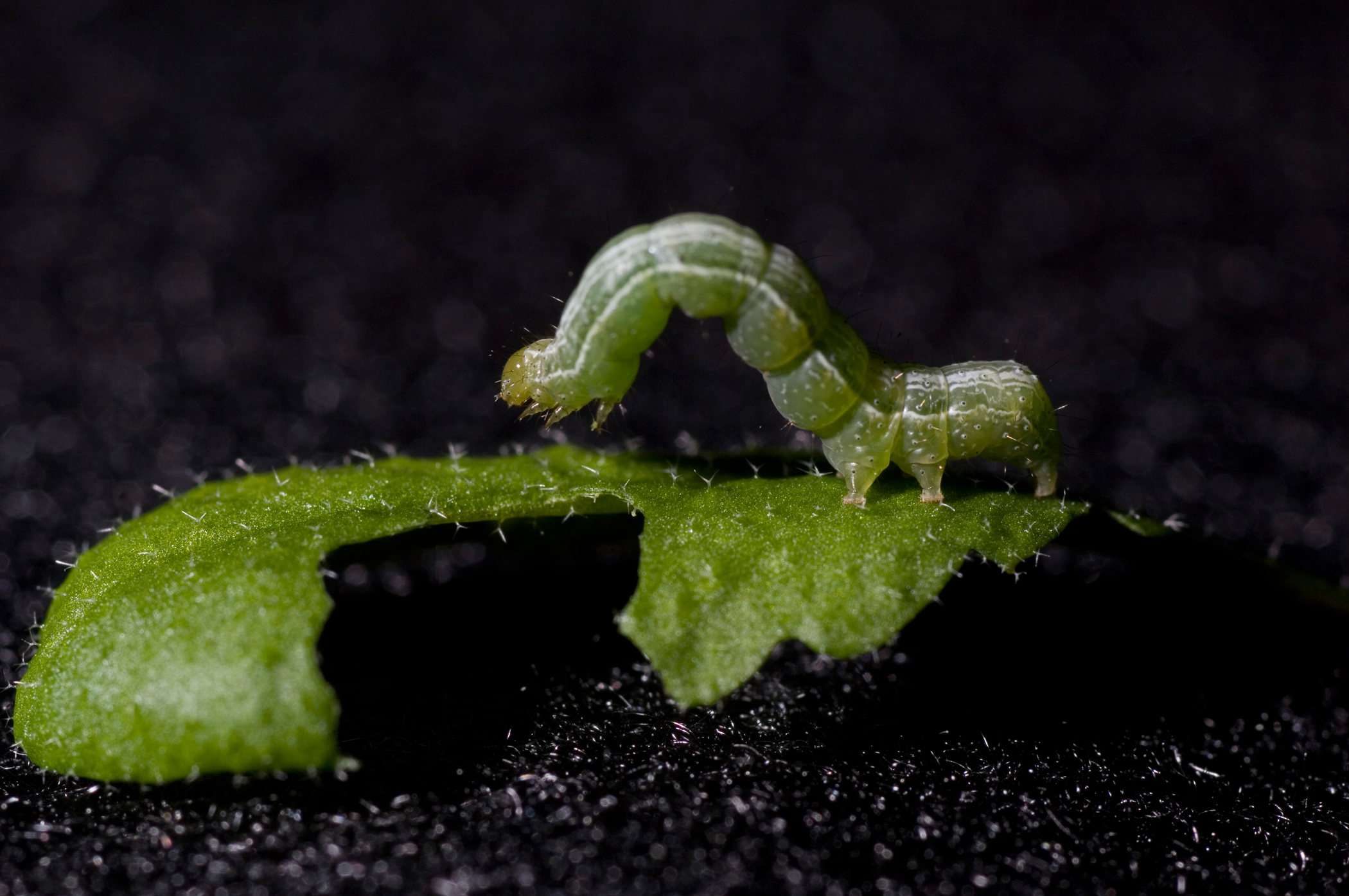
MSU has successfully engineered a plant with oily leaves -- a feat that could enhance biofuel production as well as lead to improved animal feeds. (Photo: Kurt Stepnitz)
CURWOOD: Just ahead -- the world's biggest organism -- but first this note on emerging science from Naomi Arenberg.
ARENBERG: MmmMmmGood! That might be what some lucky caterpillars living in a Michigan State University laboratory are saying. These larvae were fed leaves engineered to contain significantly more oil than average leaves. The experiment was conducted by a research team at MSU. Their leafy goal is two-fold – first, to increase plant production of biofuels and, second, to create more nutritious feed for non-human animals.
Until now most biofuel research has worked on seeds, where oil naturally occurs, as food for the nascent plant. But the MSU team is experimenting with oil production and storage in leaves, hoping to double energy capacity by using more of the plant. The team inserted a gene from green algae into the leaf of thale cress, or Arabidopsis thaliana. That’s a small, flowering plant, widely used in genetic research because of its relatively short life cycle.
The next phase is where the caterpillars come in. To prove that the modified cress leaves were a good source of oil, the team fed them to the fuzzy, little crawlers, who gobbled them up and grew a bit more roly-poly than caterpillars in a control group.
The next experimental step will be to find a way to commercialize this development by boosting oil production in algae and grasses that can grow on land unsuitable for agriculture. So, when you next drive past a grassy field, you could be looking at a future source of fuel for your next fill-up. That’s this week’s note on emerging science. I’m Naomi Arenberg.
Related links:
- Michigan State University on Fat Worms
- Article in The Plant Cell, the journal of the American Society of Plant Biologists
The World's Largest Known Organism In Trouble
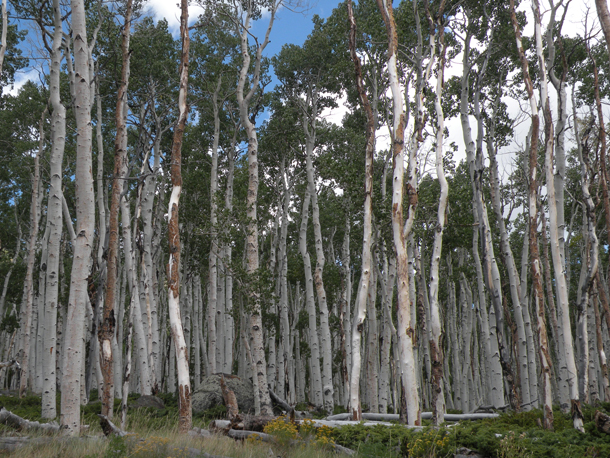
A small section of Pando. (Photo: Paul C. Rogers, Western Aspen Alliance)
CURWOOD: Quick quiz, now - what’s the largest living organism on earth? No, it’s not a blue whale. It’s a tree, a quaking aspen. That's right, a single quaking aspen in Utah covers 106 acres of land and is estimated to weigh more than six thousand metric tonnes. Aspen trees flourish in much of North America, but in the western US a genetic adaptation allows them to propagate not by seed but by cloning. By some estimations the Aspen grove known as Pando, - that's Latin for I spread, - could be shoots from a clone as much as 80,000 years old. That means it started sprouting when modern humans were migrating out of Africa. But the world’s largest organism is now under threat. Here to explain why are Paul Rogers, Director of the Western Aspen Alliance at Utah State University and Karen Mock, Professor of Conservation Genetics and Molecular Ecology at USU.
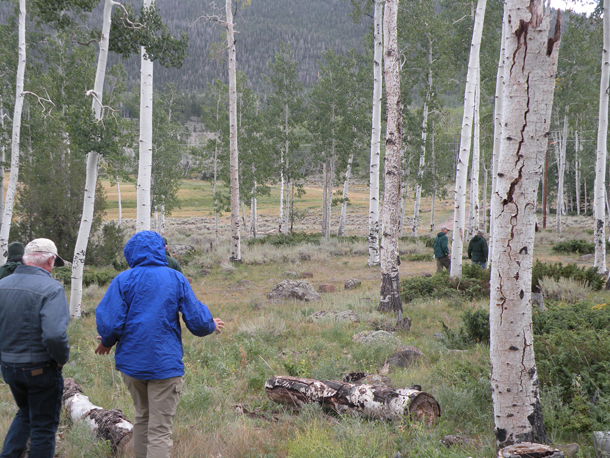
The Pando aspen clone is nearly devoid of young and middle-aged trees as a result of ongoing browsing, reducing the overall resilience of this long-lived organism. (Photo: Paul C. Rogers, Western Aspen Alliance)
MOCK: Aspen, as a species, has two basic ways of reproducing. One is by seed and one is by root shoots, and if you're talking about a single clone or single genetic individual like Pando, then that is ...you’re probably looking at roots that sprout from pre-existing trees.
CURWOOD: Now why do western Aspens reproduce this way, but the ones that we have out east don’t?
MOCK: Well, they actually both, all across the range, they reproduce both asexually and sexually. It’s just a matter of proportion. And so in the east, in northern environments, it appears that they see reproduction as a whole lot more common. And therefore, the clones tend to be a little bit smaller. In the west, seed reproduction is a little more episodic. Seed reproduction is not as common as it is in moister landscapes.
CURWOOD: So it's a matter that it's too dry then.
MOCK: Yeah, and the opportunities for seeding, the conditions that are just right for seeding, don't always occur together at the same time as you have seeds.
CURWOOD: But is Pando a girl tree or a guy tree?
MOCK: [LAUGHS} It’s a male.
CURWOOD: So Pando is a male Aspen, but really at the day is essentially sterile.
MOCK: Yeah, it's apparently triploid, which means it's got three copies of its chromosomes instead of usual two in Aspen, and that condition means that it can do just fine vegetatively, but when it comes time to produce, in this case, pollen, the pollen grains are not likely to lead to the production of seed.
CURWOOD: In terms of evolution how smart is this for a plant to not be able to reproduce sexually?
MOCK: Well, as a single plant it's probably, especially in the west, it's probably great insurance so that you can persist a long time and in certain landscapes in between these episodes of sexual reproduction. As a population, it's a little bit more questionable because, you, as a population, if you lack genetic diversity you really are at risk of not being to adapt to changing conditions.
CURWOOD: So how are scientists able to estimate Pando’s age? I hear that this could be as much as 80,000 years old, but there’s not exactly any individual trees available for counting the rings there, right?
MOCK: We all wish we knew the exact age of Pando or had some tool that we could use to get precise ages on certain clones. We really don't know the age. The 80,000 years was a estimate based on really the rates of expansion of Aspen as well as backward projections of what climates were thought to be like. And so that's a super rough estimate. We don't really have a good way to know that it's 80,000 years old.
CURWOOD: Paul Rogers, Pando isn't doing so well right now though. What’s going on?
ROGERS: Well, that's correct, Steve. Right now we have a lot of mature trees; most of the stems are about 130 years old and Aspen typically lives about 100 years, give or take a 50-year period. So at any rate, around that period where we would expect the stems to be dying off, the issue here with Pando currently is that there's very little to replace it. So we have almost no vertical diversity - if you think of a human population you might think of toddlers, teenagers, middle-age people, and mature adults – to be sensitive there – and what we have is a lot of mature adults that are starting to die fairly rapidly, but we don't have those extra generations to back them up. So that's the key to the problem there.
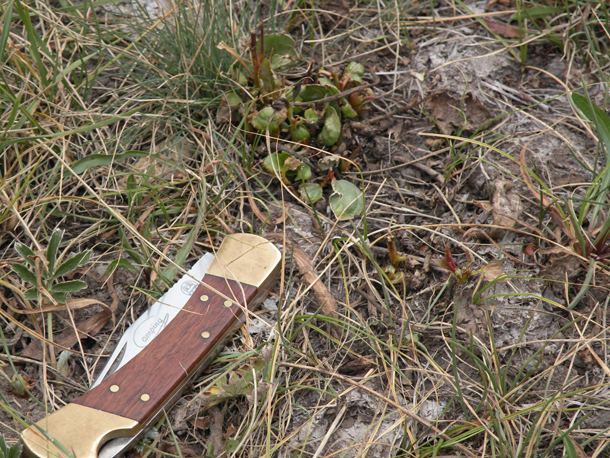
A tiny aspen stem, which sprouts from the larger clone's roots, has been browsed several times as evidenced by the small stature and bushy appearance. (Photo: Paul C. Rogers, Western Aspen Alliance)
CURWOOD: So what are the stressors for Pando now?
ROGERS: There's continual browsing of the young shoots, and these are very nutritious, very edible and primarily to larger browsers – both domestic and wild. So we have elk, deer, sheep, and cattle are the main culprits across the west, but we have to note here that Pando and a lot of Aspen in Southern Utah are growing in a fairly dry climate, so the reproduction is fairly slow as it is. And so even a small number of browsers, in this case, we think, deer, can really keep the next generation or the next set of stems at bay; and that looks like the situation that we have on the ground now.
CURWOOD: I understand that you're working on the idea of putting a fence around Pando to keep out the grazing animals. How's that working out?
ROGERS: Well, that's correct. This sort of rapid die-off of mature trees has brought us into a triage mode, you might say with the Pando clone, and that we are planning to put up an initial set of fences around about half the clone this coming summer. The US Forest Service is really instrumental in having all that done because it’s in a touristy area near a recreational lake, and it's also a tourist attraction in and of itself, the Pando clone.
CURWOOD: And who’s going to watch the fence, I mean, if there’s a hole in the fence, the elk will find there’s good eatin’.
ROGERS: You’re exactly right. So if you can imagine yourself sort of walking down the street and you look into an ice cream store and, there’s no ice cream out in the street, and it's a hot summer day, that's kind of, I think, what the browsers, the deer and elk are seeing inside that fence. And so if there's a breach, even one breach for a few days or week in the fence – and this is a lot more common than folks might think – the trees fall down and they fall over the fence and animals get in and they can eat everything. So you could lose essentially a year or more of trying to protect this clone with one or two small breaches and a week or two going by.
CURWOOD: And if your deer are anything like our deer out here in the east, they can jump!
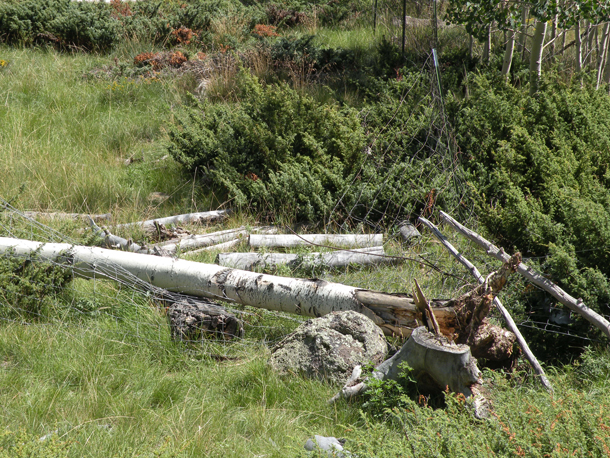
Recently fallen tree breaches inside the existing aspen fence allow browsers, such as deer, elk, and cattle, to consume protected new growth. A plan to fence much larger sections of Pando will be initiated by the US Forest Service summer 2013. (Photo: Paul C. Rogers, Western Aspen Alliance.)
ROGERS: That's true and you know I found out they can get under the fences too. They are quite crafty and some of these deer have gotten trapped in there, and then it’s unhealthy for the deer as well because there's not a water source in there, and they can be essentially caged in.
CURWOOD: Could there be there are not enough wolves?
ROGERS: That could be that there's not predators. That's certainly a factor in there but we also have this whole system pushed further to the edge because of climate. So we feel like we’re accelerating the rate of die-off for the mature trees. And the more mature trees that are dead, the engine underground, which is the root system, has less energy to push up new recruits.
CURWOOD: I understand this is the largest known Aspen clone, but, of course, that doesn't mean there aren't potentially bigger ones out there. Where you guys looking for them?
MOCK: We don't have a program where we’re actively looking for large clones. Both of our guesses are that there are probably larger clones out there, but there's not a systematic survey going on to find such a thing. This clone was probably discovered because the road goes right through the middle of it. It also has some morphological differences, and differences in the leaves and the stems from the adjacent clones. And so the boundaries are pretty easy to see.
CURWOOD: So when the leaves come out in the spring, do they all come out at the same time?
MOCK: Basically, yes, it is a little bit dependent on the size of the particular tree, but that is one of the most reliable ways to actually distinguish different clones because their timing and their day-length perceptions does tend to be a little bit different.
CURWOOD: And then at the end of the season, they pretty much drop the leaves at the same time, or change color at the same time?
MOCK: They do, but it's pretty striking. You can look up across these western landscapes and see very clear outlines of different leaf colors. It’s very dramatic and beautiful.
CURWOOD: Tell me what it was like when you first saw Pando?
ROGERS: That's a great question, Steve. The first time I went there, I actually saw one of those deer caught inside the fence. And the Forest Service individual who was giving us the tour was sort of embarrassed. But what I saw there was a very dry forest. We walked all through it, and this was only about five years ago. We didn't see near the rate of the overstory or the mature trees dying as we do now, so something seems to be happening there fairly quickly, and perhaps there's some sort of threshold that’s been crossed in terms of drought, and insects and disease. I mean, we can fence it off, but we cannot fence all the western landscape. Really it's a microcosm for a much larger problem, particularly in the southwest, but in many parts of the western states.
CURWOOD: Karen, what was it like when you first saw Pando?
MOSS: Oh, to me it’s philosophically...it’s just sort of a mind-blowing issue that you could have that many trees come from one seed and live for such a long time. Really, I think it challenges our human notions of both individuality and mortality. And it’s kind of fun to be challenged that way.
CURWOOD: Karen Mock is a Professor of Molecular Ecology at Utah State University, and Paul Rogers is the Director of the Western Aspen Alliance at USU. Thank you both for taking this time.
ROBERS: Thanks for having us on, Steve.
MOCK: Thanks so much.
Related links:
- Western Aspen Alliance
- More about Paul C. Rogers
- More about Karen Mock
- Leaf and Limb blog: The World's Oldest Trees
- Wired: The Oldest Trees on the Planet
[MUSIC: Daft Punk “Motherboard” from Random Access Memories (Columbia Records 2013)
CURWOOD: Coming up – Some bad dogs can learn to help people. That’s just ahead on Living on Earth!
ANNOUNCER: Funding for Living on Earth comes from the Grantham Foundation for the protection of the environment. Supporting strategic communications and collaboration in solving the world’s most pressing environmental problems. The Kendeda Fund, furthering the values that contribute to a healthy planet, and Gilman Ordway for coverage of conservation and environmental change. This is PRI, Public Radio International.
[CUTAWAY MUSIC: John Zorn: “The Sicilian Clan” from Naked City (Elektra Records 1990)]
Can Prairie Dogs Save Mexico's Prairie From the Desert?
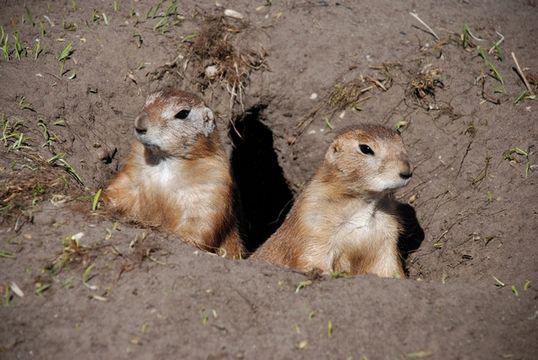
Prairie Dogs (Encyclopedia of Life)
CURWOOD: It's Living On Earth, I'm Steve Curwood. Life on our planet is incalculably diverse, with organisms that have evolved to fill every available habitat. But ecosystems are interdependent, and if you remove a species, you can upset the whole balance. Today, reporter Ari Daniel Shapiro brings news of one particular animal - and its vital role on Mexico's prairie.
SHAPIRO: Gerardo Ceballos is only 54, but he feels like he’s racing against a clock.
CEBALLOS: I don’t have too many years left.
SHAPIRO: Ceballos is refusing to let his time run out before restoring a special place in his native Mexico.
Our story actually starts well before Ceballos was born – back in the 1800s – when cattle ranching was surging through the prairies of North America, from Manitoba, Canada all the way down to Chihuahua in Mexico. And this is where the real heroes of our story come in – though, at the time they were no heroes to the cattle industry. I’m talking about Cynomys ludovicianus, or black-tailed prairie dogs.
CEBALLOS: Prairie dogs are really nice animals. They are the size of a relatively large cat.
SHAPIRO: They’re a kind of squirrel that can stand on two legs to survey the grasslands for predators. And prairie dogs thrived in North America.
CEBALLOS: Probably 30 billion prairie dogs used to live in those grasslands.
SHAPIRO: But ranchers came to believe that prairie dogs were competing with their cattle for grass, and that cows and horses were breaking their legs by stepping into the prairie dog burrows. Opinions are divided on how serious these problems were. But many ranchers were convinced – and with support from the US government – they launched an all-out war on the prairie dogs. One weapon of choice was a kind of nerve toxin.
CEBALLOS: It’s a poison that will produce convulsions, a failure of the lungs and the heart. It’s a really nasty thing.
SHAPIRO: Tablets of this stuff were tossed down into the burrows, where they produced a toxic vapor that killed everything in its wake.
CEBALLOS: We are talking about probably billions of prairie dogs.
SHAPIRO: Billions that were killed by this toxin?
CEBALLOS: By poisoning and then by the advance of agriculture. It has been one of the most dramatic, drastic exterminations of an animal by humans.
SHAPIRO: Within 50 to 60 years, prairie dogs were eradicated from 98 percent of the area they used to call home; from 30 billion animals to 1 or 2 million.
Without prairie dogs, the prairies transformed. In Mexico, the desert moved in – thanks to a shrub called mesquite. It pushes a deep root into the Earth, sucking up water, and it attracts small animals that devour the grasses ringing the mesquite.
Prairie dogs can’t stand the plant. It blocks their view of the horizon where a predator might be lurking. So they do whatever they can to get rid of it. They chew up the roots. They suck on the stems. They run around like little gardeners, keeping the desert at bay.
So with very few prairie dogs left, the mesquite helped create desert scrubland until there was little grassy prairie remaining. And with the arrival of the desert...
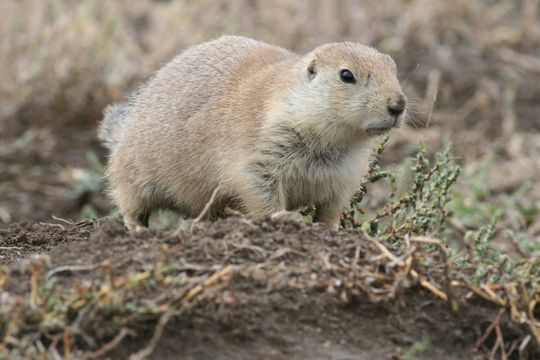
Cynomys ludovicianus Black-tailed PrairieDog (Photo: Arthur Chapman)
CEBALLOS: You lose the ability of this landscape to maintain wildlife and plants. But also the scrubland is not good for cattle.
SHAPIRO: So the land no longer supported the very ranching it was altered for.
Let’s fast forward now to the summer of 1987, when Ceballos was in the middle of his doctorate in Arizona. He and his wife were driving back to Mexico through what used to be the grasslands, in Chihuahua, an area he’d never visited before. It was pretty much all desert. But then one day...
CEBALLOS: We were not prepared mentally to see what we saw.
SHAPIRO: Grasslands waving in the wind. This area had been spared.
CEBALLOS: It was mind-blowing because all the way to the horizon – there were prairie dogs and prairie dogs and prairie dogs. And then the next day we saw badgers. Badgers are very rare in Mexico. Golden eagles are also very rare in Mexico, and we saw more than 20 there in one single day. It hit me immediately the idea that prairie dogs should have some role.
SHAPIRO: Some role in making the prairie possible. In the last 20 years, as an ecologist at the National Autonomous University of Mexico, Ceballos has shown that prairie dogs are a keystone species. That is, everything in the grassland ecosystem depends on them. Their burrows provide shelter for small mammals. Predators – like coyotes and hawks – feed on prairie dogs. These days, Ceballos is resuscitating the prairies, by reintroducing the prairie dogs.
CEBALLOS: Within one year, they destroy most of the mesquite.
SHAPIRO: He’s also reintroducing black-footed ferrets – a species that hasn’t been in Mexico for at least a hundred years, pronghorn antelopes, bighorn sheep, wolves - even bison, which he’s getting from the US. He’s partnered with environmental groups and the government to create a reserve that protects these species, and then offers local people ways to benefit economically from the grassland. And gradually, a portion of the Mexican prairies are coming back.
CEBALLOS: A good scientist has to do good research, but then has to translate it into action. There is no way that we can continue just being like historians – recording all the things that we are losing, instead of becoming actors. Now, my main objective in life is to save as many species of plants and animals as I can.
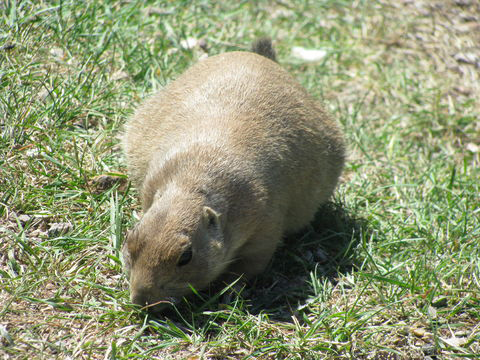
(Encyclopedia of Life)
SHAPIRO: Which is why – even at 54 – Ceballos feels he doesn’t have a moment to waste. He has a legacy to leave his country. For Living on Earth, I’m Ari Daniel Shapiro.
CURWOOD: Our story on prairie dogs is part of the series, One Species at a Time, produced by Atlantic Public Media, with support from the Encyclopedia of Life. To see some photos, follow the trail to our website loe dot org – or check out our Facebook page – it’s PRI’s Living on Earth.
Related links:
- More about the Encyclopedia of Life
- More about Ari Daniel Shapiro
[Brad Mehldau “The Falcon Will Fly Again” from Highway Rider (Nonesuch Records 2010)]
Conservation Canine

Casey is a 15 pound conservation canine. (Conservation Canines)
CURWOOD: From hunting to pulling sleds to leading the blind, throughout history dogs have performed a variety of jobs for their human companions. Now the Conservation Canine program at the University of Washington is putting man’s best friend to work for science. Joining us from the University of Washington is the founder of the Canine Conservationist program and director of the University’s Center for Conservation Biology, Professor Samuel Wasser.
Professor, welcome to Living on Earth.
WASSER: Thank you, glad to be here!
CURWOOD: So, tell us a bit about these canine conservationists. What role do these dogs play in scientific research?
WASSER: Well, essentially they are an extremely efficient way of acquiring samples. Most of the samples we use come from an animals feces or scat, and that’s because it’s loaded with a variety of physiologic and genetic measures. So, the dogs allow us to sample large bits of wilderness and also to sample multiple species often at the same time.
CURWOOD: What gave you the idea to use dogs in this way in the first place?
WASSER: Well, we wanted a method to sample animals according to their distribution in the wilderness. After looking at a number of different kinds of detection dogs: dogs that detect bad guys, dogs that are hunting narcotics, bomb dogs… it became pretty clear that the narcotics dogs are kind of the perfect models for this system, because what these are, are very high reward-driven dogs.
So, in our case, our dogs have an incredible play drive for a ball. They are so focused, that, if they know you’ve got the ball, and you throw the ball, nothing in its way will stop it. What’s really nice about this is that you can transfer this incredible drive into finding samples because the dog is so obsessed. Once it smells a sample and knows its going to get the reward from it, it will work tirelessly to find it.
CURWOOD: And once it finds the sample, you can then subject it to all this DNA testing and such to determine exactly what the animal is and what its other habits are?
WASSER: We can use the DNA in the samples to actually figure out how many animals of each species there are in the wilderness. We know the location of all those samples, so we not only know how many individuals there are, but where they are located, what areas they are avoiding. And then we can get the physiological measures from those same samples again and see if they are in areas that they really prefer, are they in better physiological health than when they’re in areas that they’re avoiding.
And in doing so it allows us to see what are the pressures facing these animals, and as those pressures change, how does it affect their physiological health and well being.
CURWOOD: Wow, that’s a lot to learn from a bit of poop!
WASSER: It’s fantastic, actually.
CURWOOD: Where do your dogs come from?
WASSER: I mentioned that the dogs have an extremely high ball drive. One of the things that happens to these kinds of dogs is that when people get them as pets, they find out after the animal gets to be a year and a half, two years old, that they simply can’t keep it because it will just do anything for its ball and it’s just relentless - it just won’t stop.
So people end up giving those dogs to the pound or shelters hoping that someone else will adopt them. But the problem is that those dogs are so wild that nobody wants to adopt them. We go through the pounds and we look for the dog that has this completely obsessive drive for the ball – that nothing else matters when it sees the ball – and that’s the animal that we choose for our work.

The ideal conservation canine is intensely focused and has an insatiable urge to play ball. (Conservation Canines)
CURWOOD: I understand that your conservation canines are working with the Jemez mountain salamander. How are they helping to save this salamander?
WASSER: Well, the Jemez mountain salamander is endangered. We have been working with the Nature Conservancy and the US Fish and Wildlife Service to find these salamanders in their remote wilderness habitat. They’re very small, they’re just a few inches long, and they’re no thicker than a pencil and very cryptically colored. So they’re very difficult to find, and when they’re above ground, it’s only for this short period of time in the monsoon when there’s good rain then you need to be able to locate them quickly. So, our dogs have been trying to help the Nature Conservancy and the US Fish and Wildlife Service to locate these lizards [ED - THEY ARE CORRECTLY AMPHIBIANS, NOT LIZARDS] in their remote habitat.
CURWOOD: Now, I understand that your canine conservation program is working in the Alberta tar sands, it’s a very controversial area - this business of extracting oil from tar sands. What do these dogs do up there?
WASSER: For four years, we brought dog teams into the tar sands. Now, we went through and we monitored the impacts of the oil development on the caribou, the moose, its competitor, deer, and their predator, the wolf, over the period when the oil companies were there, which is in the winter when the ground is deeply frozen, it’s about minus 10 Celsius and the snow is two feet deep.
And the reason it was important to know their impacts on the caribou was because the caribou were believed to be going extinct in Alberta within the next two decades. We collected samples over the landscapes and the four dogs in the ten weeks we were there got about 1500 samples, which allowed us to get accurate population estimates of the caribou, moose and wolf, and allowed us to see their distribution across the landscape, and allowed us to see their physiological health and how this was changing with the number of oil workers on the landscape.
CURWOOD: And the mission was to find out whether or not the caribou were in fact endangered and you found…?
WASSER: The first thing we found was that the caribou were not declining anywhere near as quickly as government projections had implied. There were well over twice as many caribou in the area than the government projected.
CURWOOD: How then did this affect government policy?
WASSER: The government was arguing that the best way to deal with the situation is to remove 60 to 80 percent of the wolves on the landscape. Well, what we showed was that the wolf was actually taking very, very few caribou. They were really heavily focused on deer. If they took 60 to 80 percent of the wolves out of the population, the deer would undergo a population explosion in the area. And deer eat everything. They also bring with them a number of diseases like chronic wasting diseases, a variety of parasites that can jump to caribou and potentially really cause great harm to the ecosystem.
CURWOOD: So, if wolves aren’t the problem, then what is?
WASSER: The real problem appears to be food. In the winter time, the vast majority of caribou are pregnant, and these pregnant females are eating almost entirely lichen. The lichen is very, very rich in glucose, and that is the primary food that a fetus consumes when it is developing. So that told us that lichen was the key nutrient that we needed to protect and that variation in the amount of lichen transfers to variation in pregnancy health. One of the things that we also found was that the soil conditions that lichens grow in are the same kinds of soil conditions that are good for building roads.
CURWOOD: Sandy, and smooth, and even?
WASSER: Yes. And what that implied was that the number of people on the landscape, and therefore the number of people using those roads could be preventing the caribou from accessing thoe lichen, even though the lichen was there. They were afraid to go there because there were so many people on the landscape, and people to them are also viewed as a predator.
CURWOOD: So, the answer there was to ask people to stop spooking the caribou.
WASSER: Right. And, of course, we’re talking about an area where there’s billions of dollars at stake here, so you can’t just say ‘just stop’ because that’s not going to happen. But we were able to make recommendations about how they could work on the landscapes that would minimize the impacts on the caribou, and there are two really important aspects that we are trying to get them to implement.
One is that instead of extracting oil very diffusely over the entire landscape, that if they were able to concentrate their activity at any point in time in a certain area, work that area and then move to a new area, the caribou would be much better able to move around in areas that they could still access lichen.
And the second recommendation is to be more thoughtful about where they put these high-use roads. Now, giving them recommendations is one thing. The nice thing that’s happening is that the oil companies are coming to us and saying: OK, let’s get together and think about what is practical, what is not, and how can we best move forward in a manner that is going to put the animals at less risk. We’ll see what happens.
CURWOOD: So, how much do your dogs enjoy this work?
WASSER: Huh. They love what they do! I mean, think about it, you’re dealing with a dog that is just a maniac for its ball and all day long it’s running through the woods, smelling poop and getting a ball reward. I mean, what could be better if you are a dog?
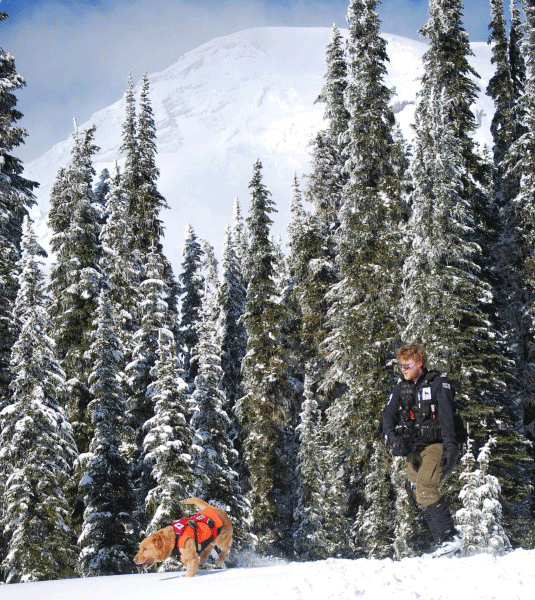
(Conservation Canines)
CURWOOD: Samuel Wasser is professor of conservation biology and founder of the Canine Conservation Program at the University of Washington. Thank you so much, sir.
WASSER: Thank you, it’s my pleasure.
[MUSIC: Dave Douglas “Dog Star” from Moonshine (Koch Records 2008)]
CURWOOD: Living on Earth is produced by the World Media Foundation. Naomi Arenberg, Bobby Bascomb, Emmett Fitzgerald, Helen Palmer, Poncie Rutsch, Erin Weeks, Adelaide Chen, James Curwood, Jennifer Marquis and Gabriela Romanow all help to make our show. Jeff Turton is our technical director. Alison Lirish Dean composed our themes. You can find us anytime at LOE.org, and check out our Facebook page, it’s PRI’s Living on Earth. And we tweet from @LivingOnEarth. I'm Steve Curwood. Thanks for listening.
ANNOUNCER 1: Funding for Living on Earth comes from the Grantham Foundation for the protection of the environment. Supporting strategic communications and collaboration in solving the world’s most pressing environmental problems. The Kendeda Fund, furthering the values that contribute to a healthy planet, and Gilman Ordway for coverage of conservation and environmental change. Living on Earth is also supported by a friend of Red Tomato, supplier of righteous fruits and vegetables from northeast family farms, www.redtomato.org. This is PRI, Public Radio International.
ANNOUNCER 2: PRI, Public Radio International.
Living on Earth wants to hear from you!
Living on Earth
62 Calef Highway, Suite 212
Lee, NH 03861
Telephone: 617-287-4121
E-mail: comments@loe.org
Newsletter [Click here]
Donate to Living on Earth!
Living on Earth is an independent media program and relies entirely on contributions from listeners and institutions supporting public service. Please donate now to preserve an independent environmental voice.
NewsletterLiving on Earth offers a weekly delivery of the show's rundown to your mailbox. Sign up for our newsletter today!
 Sailors For The Sea: Be the change you want to sea.
Sailors For The Sea: Be the change you want to sea.
 The Grantham Foundation for the Protection of the Environment: Committed to protecting and improving the health of the global environment.
The Grantham Foundation for the Protection of the Environment: Committed to protecting and improving the health of the global environment.
 Contribute to Living on Earth and receive, as our gift to you, an archival print of one of Mark Seth Lender's extraordinary wildlife photographs. Follow the link to see Mark's current collection of photographs.
Contribute to Living on Earth and receive, as our gift to you, an archival print of one of Mark Seth Lender's extraordinary wildlife photographs. Follow the link to see Mark's current collection of photographs.
 Buy a signed copy of Mark Seth Lender's book Smeagull the Seagull & support Living on Earth
Buy a signed copy of Mark Seth Lender's book Smeagull the Seagull & support Living on Earth

